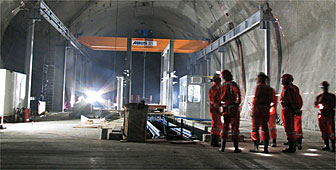Railways promote tunnel tourism

The building site of the world's longest railway tunnel is attracting a surprisingly large number of visitors.
The 57-kilometre Gotthard base tunnel has already welcomed more than 100,000 people -nearly half of them from abroad.
In 2013, trains using the new tunnel will be able to carry passengers and freight through the Alps in about 20 minutes. But building work on the tunnel is moving slowly, as is evident during a visit to the site.
Geologist Yves Bonanomi was my guide through the dark galleries and caverns at the site in Sedrun in canton Graubünden – one of five sites where work is underway.
He explained all of the finer details of drilling and boring, shone his flashlight on the mammoth machinery, and lead me through the muck.
In the dark
It then dawned on me that I was really stumbling through the dark. The tunnel we were in wasn’t the railway tunnel, but only one of a myriad of access, emergency and ventilation passages that have to be completed before the real work can begin.
After six years on the job, the miners, heavy machine operators and other tunnel specialists have yet to begin work on the two single-track tunnels that will comprise the Gotthard Base Tunnel.
Bonanomi showed me a model of the completed tunnel back at the information centre in Sedrun run by Alp Transit, the company responsible for the huge multi-billion franc project.
More caverns than rock
“The tunnel system is displayed here with only one shaft,” he explains. “We will dig a second shaft, and we’ll eventually have more caverns than rock in this mountain!”
The tunnel is the piece de resistance of Switzerland’s efforts to link up to Europe’s high-speed railway network, and more importantly, to move freight using the vital north-south axis off congested roads and on to rail.
A key advantage of the tunnel will be speed, as shown by one of the many interactive and hands-on displays in the information centre. Visitors watch model trains, trucks and horses race across the Alps to see which reaches the other side first.
Trucks and horses
The high-speed trains win of course, with the trucks and horses pulling up the rear.
“The speed of the model truck is 80 kilometres an hour,” says Bonanomi. “But this doesn’t take into account the fact that trucks today have to queue at the north and south portals for three to four hours.
“That means the trucks’ average speed is actually only ten kilometres an hour, so the horses which were used 130 years ago were faster than the trucks today.”
But the focus is on the speed of the trains. The new line is being dug in a perfectly horizontal line at about the same altitude as Zurich, so the trains will not have to make any unnecessary climbs in accessing or moving through the tunnel, as is currently the case in most alpine tunnels.
Travel times between Zurich and Milan will be cut by an hour to two hours and 40 minutes – fast enough to make regional airlines nervous.
Until then, there is still a lot of rock to get through. And when serious digging begins, daily progress will be measured in metres, and for a few years only in centimetres.
Soft rock
That’s when Alp Transit will have reached a short section of mountain made mainly of a soft rock which can jam the drilling teeth of tunnel boring machines.
The builders will have to resort to classic drilling and blasting to inch their way forward.
“The difficult conditions make it more interesting for engineers and geologists than working with granite,” says Bonanomi. “With granite, the machines do all the work for you. We now have to develop new methods, and that will provide us with the know-how that we can sell to the world.”
Groups of at least ten people are allowed to visit the site at Sedrun with advance warning. Because of demand, they are advised to book at least a year in advance.
by Dale Bechtel

In compliance with the JTI standards
More: SWI swissinfo.ch certified by the Journalism Trust Initiative

You can find an overview of ongoing debates with our journalists here. Please join us!
If you want to start a conversation about a topic raised in this article or want to report factual errors, email us at english@swissinfo.ch.